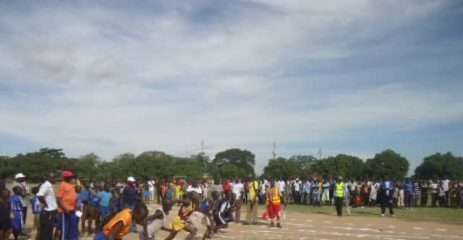By Susanna Neumann
“Girls and women with disabilities should not be ignored because sport is their right!” (Interviewee 6, 01.08.2019)
“Sport is the key; it is the main key of everything! Sport brings us together, no matter the disability, no matter the gender, no matter the status, no matter where you come from. Sport will always unite us together!” (Interviewee 9, 08.08.2019)
Introduction
People with disabilities (PWD) are considered as the largest, poorest and most marginalised minority. More than a billion people – corresponding to 15% of the world’s population – are living with some form of disability, out of which half are women and girls (WHO & World Bank, 2011).
Girls and women with disabilities (GWWD) face many barriers and obstacles in their struggle for (basic) human rights including equality in and access to sports. They are subject to multiple instances of discrimination, on the grounds of both gender and disability (UNDESA, 2016).
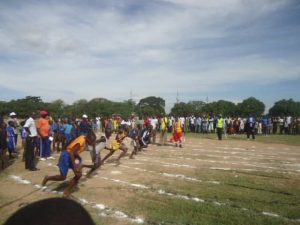 While a substantive body of work has focused upon gender and disability discrimination in and through sport in high income countries and wealthy contexts there is less evidence about GWWD’s sport experiences in low and middle-income countries (LMIC) in sub-Saharan Africa (SSA). 80% of the world’s disabled people live in LMICs (UNDESA, 2019; Connell, 2011; Grech & Soldatic, 2014; Karr, 2011; WHO, 2005).
While a substantive body of work has focused upon gender and disability discrimination in and through sport in high income countries and wealthy contexts there is less evidence about GWWD’s sport experiences in low and middle-income countries (LMIC) in sub-Saharan Africa (SSA). 80% of the world’s disabled people live in LMICs (UNDESA, 2019; Connell, 2011; Grech & Soldatic, 2014; Karr, 2011; WHO, 2005).
The Study
The small qualitative study informing the research in this blog aimed to add to a limited body of knowledge of the sport experiences of GWWD in SSA, and Uganda in particular. Voice was given to nine (former) female athletes with different physical disabilities, as well as related stakeholders from Uganda (four interviewees), Kenya, Benin, Nigeria, the Netherlands and the United States of America. In total, six women and three men were interviewed.
Barriers and Challenges
Those interviewed gave voice to a number of barriers and challenges faced by girls and women’s experiences of sport within this context. These were as follows:
I. Cultural Barriers and Negative Perceptions
Cultural factors and negative attitudes were identified as the greatest barriers facing PWDs’ to participation in sport. All interviewees indicated that GWWD in SSA experience multiple instances of discrimination based on gender and disability due to “a deeply rooted patriarchal ideology”.
“That particular cultural factor is a big problem. Because when you have not accepted that this category of human beings has a lot to contribute to the society, you don’t see anything good that can come from that section of the population.” (Interviewee 3, 24.07.2019)
“Perception is what we need to change to overcome those challenges. When it comes to women and girls, oh it is terrible!” (Interviewee 2, 03.07.2019)
“The complexity of culture and tribal, religion – all these elements make it hard for women.” (Interviewee 5, 01.08.2019)
II. Lack of Self-Esteem and Self-Confidence
A lack of self-esteem and self-confidence among GWWD, which prevents them from participating in sport and physical activity was also highlighted.
“Oh a women with disability, how are you going for sitting volleyball, how are you going to run?” It is even: “In our culture it is not allowed, how are you going to compete with men?” Things like that. So for the women, they completely think it’s impossible. They make them loose their self-esteem and once they lose that, it gets really, really difficult.”
(Interviewee 2, 03.07.2019)
“Me, personally, I used to play rugby and because of the outcomes of, you know, having muscles I stopped. Just like that. Because I did not want to have that body”
(Interviewee 6, 01.08.2019)
III. Lack of Awareness and Visibility
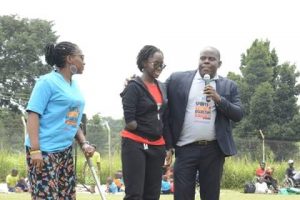
The lack of awareness and visibility of disability sport in SSA was seen as a further barrier. The importance of educating and sensitising the public, not only to overcome negative perceptions but also to show that GWWD can play sports was strongly emphasised.
Sport is an effective tool to overcome these barriers. Various scholars have noted that sport provides a context to highlight ability rather than disability. This increases the self-confidence of GWWD as well as enabling sports based interventions aimed at challenging and changing the negative attitudes of society (Bantjes et al., 2019, Albrecht et al., 2019, de Cruz et al., 2019, Bantjes & Schwartz, 2018, Corazza & Dyer, 2017, Devine et al., 2017, Silva & Howe, 2016; Martin, 2007, 2013; Kosma et al., 2007; Giacobbi et al., 2006; Farias-Tomaszewski et al., 2001; Taub & Greer, 2000).
 Through sport, “we can demonstrate what these folks are capable of and then it opens doors to do other things including employment, access to voting and things like that.”
Through sport, “we can demonstrate what these folks are capable of and then it opens doors to do other things including employment, access to voting and things like that.”
(Interviewee 1, 01.07.2019)
“It is important to engage different stakeholders in different activities, like awareness creation, like advocacy and lobbing, like showcasing their ability within disability.” (Interviewee 2, 03.07.2019)
“Sport has contributed a lot to changing the general perception of PWD in this country.” (Interviewee 2, 03.07.2019)
“It was not easy for me to begin sport. It is after a lot of programs of awareness raising like demonstrations or film projections that I decided to practice sport. I’m from the first generation of women doing sport.” (Interviewee 4, 27.07.2019)
“They need to be educated on the benefits of sports, and on what happens when they participate in sports. And also see that they are responsible of their lives, so it shouldn’t be their husband or parents or any other person’s fault.” (Interviewee 6, 01.08.2019)
IV. Sexual Harassment and Abuse
The results of this study emphasised the importance of providing safe spaces as well as support systems for GWWD in sport. The voices asserted that participants face a high risk of gender-based violence and sexual harassment by their coaches and/or managers. This has been identified as “one of the biggest problems” faced by GWWD.
“They are harassed, sexually harassed by their fellow sportsmen or team leaders or coaches or managers. It keeps them away, disabled or not.” (Interviewee 6, 01.08.2019)
“If the facility is far away from where they are coming from, because anything can happen along between the facility and the home of the athlete. So they need to know that they are safe. They need to know that they won’t be sexual harassed or abused. By probably their coaches, or managers, or anyone in charge. … Provision of safe spaces would be good. But sometimes it is not possible. Sometimes men washrooms and female washrooms, they are close to each other.” (Interviewee 6, 01.08.2019)
V. Structural Barriers
Lack of money and the insufficient implementation of rights and legislations regarding PWD such as the UN Convention on the Rights of Persons with Disabilities, are structural barriers that make it more difficult for PWD to claim their right to participate in sport. It was stated that various national legislations and policies regarding PWD in Uganda exist. However, the right of PWD to participate in sport is still not guaranteed. Addressing these issues will also require a stronger effort to reduce corruption, which remains a problem in many African countries (Chiweshe, 2014; Kakonge, 2016; Mwisukha & Mabagala, 2011).
“There is just so very little money and there is so much corruption, that often money goes into the pockets of those that are not always the most reliant and so it really depends upon who gets elected and who ended to run these Paralympic Committees.”
(Interviewee 1, 01.07.2019)
“Most of the women are single mothers. They really focus on how to make money. Or how to parent, or how to make sure they raise their kids they have given birth to.”
(Interviewee 6, 01.08.2019)
“They are the poorest countries but there are some very, very, very rich bastards. Most of the time they are also in the top and in the governments.” (Interviewee 5, 01.08.2019)
The integration of GWWD in sport in Uganda and other parts of SSA has not yet been achieved because of a number of obstacles and barriers. According to Marshall (2018), gender parity in sports will not be achieved any time soon, especially for GWWD – neither in SSA nor in other parts of the world. However, in the last few years, countries have begun to adopt measures to improve gender equality in sport.
Sport for Change in Uganda
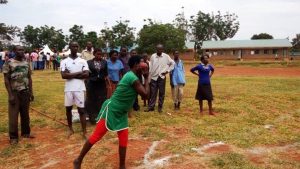 Although this study is small, it is the first to report that such trends and experiences are also apparent in Uganda. By drawing upon the traditionally marginalised voices and experiences of female athletes with disabilities and related stakeholders, several progressive, and previously unexamined efforts made by the Paralympic movement in Uganda to address the discrimination of GWWD in sport were revealed.
Although this study is small, it is the first to report that such trends and experiences are also apparent in Uganda. By drawing upon the traditionally marginalised voices and experiences of female athletes with disabilities and related stakeholders, several progressive, and previously unexamined efforts made by the Paralympic movement in Uganda to address the discrimination of GWWD in sport were revealed.
Quotas and Gender Parity
Recently, the Uganda Paralympic Committee (UPC) applied a top-down approach by introducing quotas to increase the number of WWD in sport leadership positions. The most recent approach involved an explicit demand to nominate a female vice president for every male president in office. Quotas were also applied at the athlete level during sport competitions.
“(…) at least 40 percent of the leadership goes to women. From the Paralympic Committee and the 19 sport organisations. So those 19 sport associations, when they are electing their leadership, 40 percent must be women.” (Interviewee 2, 03.07.2019)
“If we are sending for example, four athletes, two must be women, two must be men. If we are sending three, then two must be women and one must be a man. It has helped us to address such issues.” (Interviewee 2, 03.07.2019)
More emphasis is being placed on increasing awareness and visibility. Nationwide sensitisation campaigns involving the media are being conducted to change the public perception of what GWWD are capable of and how sport can be a tool for prosperity. A recent achievement in this regard was the collaboration of the UPC with universities in the form of sport scholarships.
“If a PWD is engaging in sports at any level the competition of entering universities becomes then very easy for those in sports. So that one has opened up the eyes of the public. Oh, let my child go and participate in sports, because there is this opportunity.”
(Interviewee 2, 03.07.2019)
“We can sensitize these parents by having door-to-door meetings or creating something, like a festival for girls, and we can invite parents to come and see what their children can do.” (Interviewee 8, 07.08.2019)
Overview
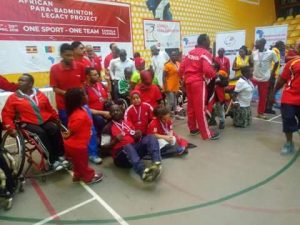 This study confirmed that GWWD face a great deal of discrimination in SSA. Various contextual and cultural barriers and challenges hinder GWWD in realising and enabling their right to participate in sport. One of the remarkable findings of this study is the efforts being made to overcome gender inequality in and through sport for GWWD in Uganda.
This study confirmed that GWWD face a great deal of discrimination in SSA. Various contextual and cultural barriers and challenges hinder GWWD in realising and enabling their right to participate in sport. One of the remarkable findings of this study is the efforts being made to overcome gender inequality in and through sport for GWWD in Uganda.
Recommendations
This research based blog provides insights into some of the factors that should be taken into account when addressing gender discrimination in disability sport in SSA:
- Cultural beliefs and viewpoints of disability must be understood because they are so influential that in some cases they are limiting PWD more than the impairment itself (Groce, 1999, Haihambo & Lightfoot, 2010).
- Raising awareness and providing education about sport opportunities for GWWD are crucial to overcome cultural barriers and to change the perception of society, especially parents. Sport festivals have proven to be a good medium for this purpose. Particular attention should be paid to communities in rural areas, where the rights and opportunities of PWD are less well known.
- Workshops should be conducted and further measures should be taken to empower GWWD and to increase their self-esteem.
- Safe spaces and (social) support systems for GWWD should be provided to minimise the risk of sexual harassment.
- Schools are the main facilitators of inclusive sport opportunities and for many disabled girls, schools are the easiest and first point of contact with sport and PA. For this reason, it is important to ensure that GWD attend school. Further, schools need to be educated about inclusive sport and adapted physical activity.
- Governments should update their commitments to the cause of PWD, and GWWD in particular because most existing policies and legislations have not been translated into reality (Onyewadume, 2007, Aldersey, 2010).

